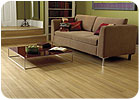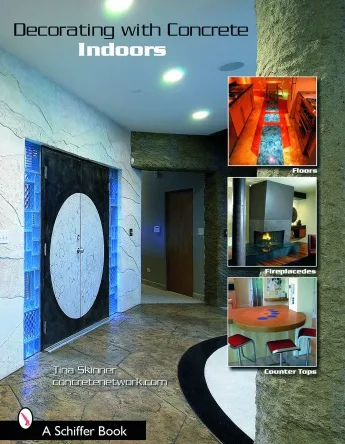Keep it quiet: Understanding why floors squeak

Catching
the eye, not the ear. When Amtico introduced this upscale Fused Birch resilient
floor in June, it promised "traditional wood aesthetics" using more
contemporary material. While the authentic looking linear grain makes it look
like the real thing, if it is properly installed it will always be free of
squeaks or any other unwelcome sound, even when walked on.
There are few problems that will destroy a customer’s confidence in their newly installed floor faster than an annoying “squeak.” When they hear that dreaded sound rising up from the floor, they know something is not right and they begin to point fingers. Often the blame falls on the flooring retailer or whoever sold them the floor. That’s unfortunate because it is really something that is out of their control. Usually, the cause of the squeak is something that can be avoided, so let’s look at some of the factors in new construction that contribute to noisy floors.
Lumber used in today’s structures is usually higher in moisture content than in the past. Wet or green lumber (greater than 19% moisture content) is the norm. The lumber is also subjected to drier conditions and will dry to a moisture content of between 6 to 12 %. As lumber dries, shrinkage takes place. For example a Douglas fir or pine will shrink .0026” per inch per percentage of moisture content loss. This will cause the nails to loosen, which in turn allows the underlayment to move up and down on the shank of the nail. Thus causing the squeak. Lumber shrinkage is also the major cause of nail pops, which are extremely difficult to repair.
Improper subfloor or underlayment spacing. Floor panels will expand slightly if they are installed over a substrate with higher moisture content. If no allowances have been made for spacing of the joints, this movement will cause the underlayment to buckle, pulling the fastener loose. This is especially true when improper fasteners are used, the correct fastening pattern was not followed or the fasteners are too far from the underlayment joint. Once the moisture content lowers the wood will shrink, resulting in a loose panel free to move up and down on the shank of the fastener.
Improperly glued floor construction. The construction industry has used the widely accepted “Sturd-I-Flor system” for years. This involves a non-staining construction adhesive used to glue and then nail the subfloor to the joist. Sometimes a carpenter installing subfloor panels will either spread more adhesive than can be covered or fail to have the panel nailed in place before the adhesive skins over and begins to harden. The result is not only a poor adhesive bond, but built-in gaps in the adhesive bead. This allows the panel to move up and down on the shank of the nail, resulting in the squeak.
Improper fastening technique. Power nailing has become increasingly popular particularly when “fast track” building techniques are employed. Unfortunately, when you are using a pneumatic nailer it is impossible to tell if the nail has barely missed the edge of the joist, allowing the shank of the nail to rub against the edge of the joist. Squeaks can also come in the spacing and fastening of the underlayment panels. Underlayment must be properly fastened at the edges, usually within 3/8” of the edge and then spaced properly along the edge. Spacing along the edge and keeping the fastener close enough to the edge will prevent the edges from rubbing. Any rubbing at the edges of the underlayment can cause a squeak.
Squeaks can also originate between the underlayment and the subfloor. This is caused by improper nailing patterns, improper fasteners, or fasteners that are driven too deep into the underlayment. Each can lead to movement between the underlayment and the subfloor when subjected to loads, causing deflection of the substrate. Unwanted noises between the underlayment and the subfloor can come if you install underlayment over a dirty, gritty surface or if there is a sticky residue on the subfloor or if you are attempting to glue the underlayment to the subfloor.
Lack of or improper blocking. The blocking of the joists is normally completed prior to the installation of the subfloor. The norm is to nail the blocking from the top, then after the structure is enclosed move to the bottom. In more and more cases the blocking is either not done or is not secured on the bottom. This allows the floor joist, when subjected to a bearing load, to rotate or slide rather than transferring the load to the other joist.
Improper fastening of interior wall partitions. If there is a squeak near an interior wall partition, the squeak may be a result of the wall plate being anchored to the subfloor rather than to the floor joist. Occasionally, the practice of carpenters is to nail the lower plate into the subfloor which, when walked on, will deflect slightly, allowing the subfloor to move and rub on the shank of the nail.
Joist hangers. When joists are properly set in joist hangers, they should rest firmly on the bottom of the hanger and should be anchored in all of the fastening holes provided. An all too common practice of carpenters is to fasten only the top of the joist hanger. As dimensional lumber dries, it shrinks away from the hanger and can move freely. The squeak occurs when the components rub together.
Improper nails. The uses of fasteners that are not designed for flooring purposes, such as smooth shanked or coated nails, are a major cause of squeaks. Coated nails are believed to have a superior hold. Initially this is true, but over time deterioration occurs between the coating and the nail. The shrinkage in lumber is not limited to just its outside dimensions and eventually it can compromise the withdrawal resistance of the nail, leaving a fastener with a poor hold of the panels. With deflection of the substrate the smooth shank of the fastener will start to withdraw. Then the panels will start to rub on the fastener, with a squeak resulting.
Unevenness of joists. The use of lower grades of dimensional lumber, high yield growth lumber and higher moisture content in lumber has lead to much more floor joist movement . It comes as the lumber dries to its in-service moisture content and it will result in the lumber shrinking, twisting and bowing. When floor joists are installed they are supposed to be “crowned” upward. If the joists are not “crowned” or are placed randomly, the subfloor will be forced to bridge the high and low joists, creating gaps between the subfloor and the low joists. This will generate squeaks.
Ductwork. Structures with forced-air heating systems usually have the ductwork running between the joists and come up through the floor where the discharge vent is located. Squeaks occur when the discharge vent is cut too tight to the ductwork, allowing the deflection of the substrate to rub on the metal ductwork.
The above is an attempt to help you understand the causes of squeaks and to help prevent them from occurring. All squeaks can be eliminated. It is a matter of determining the source of the squeak and then taking corrective action. While this sounds simple, it may not be. Sometimes the elimination of an annoying squeak can be a major undertaking. But remember, great flooring should be seen and not heard.
Looking for a reprint of this article?
From high-res PDFs to custom plaques, order your copy today!







